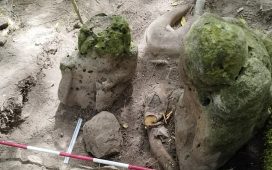Andhra Pradesh Public Service Commission has released the new syllabus for Group-2 Exams on 27th April. Check no. of posts, complete syllabus and guidance below.
APPSC has released new syllabus for Group-2 exams 2023. It is known that Group-2 notification for 897 posts have been released. According to this new syllabus, the candidates will be selected through a two-stage written test for a total of 450 marks.
In the first stage, the prelims (screening) exam will be conducted for 150 marks and in the second stage the main exam will be conducted for 300 marks. Only those candidates who qualify the prelims exam are eligible to write the main exam.
APPSC Group-2 Notification for 897 Posts Released: Complete Details Here
As per Revised Syllabus & Exam Pattern, screening test is conducted for 150 marks from General Studies & Mental Ability only. General Studies is excluded from Mains examination. It will have two papers of 150 marks each instead of three in the existing scheme.
APPSC Group-2 Prelims 2023 Exam Pattern:
Prelims Exam Time: 150 minutes
APPSC Group-2 Prelims Syllabus 2023
INDIAN HISTORY (30M)
- Ancient History: Salient features of Indus Valley Civilization and Vedic age – Emergency of Buddhism and Jainism – Mauryan Empire and Gupta Empire: Their administration, Socio-Economic and Religious Conditions, Art and Architecture, Literature – Harshavardhana and his Achievements.
- Medieval History: The Chola Administrative System – Delhi Sultanate and The Mughal Empire:Their Administration, Socio-Economic and Religious Conditions, Art and Architecture, Language and Literature – Bhakti and Sufi Movements – Shivaji and the rise of Maratha Empire -Advent of Europeans.
- Modern History: 1857 Revolt and its Impact – Rise and Consolidation of British Power in India – Changes in Administration, Social and Cultural Spheres – Social and Religious Reform Movements in the 19th and 20thCentury – Indian National Movement: it’s various stages and important contributors and contributions from different parts of the country – Post Independence Consolidation and Reorganization within the country.
GEOGRAPHY (30M)
- General and Physical Geography: The Earth in our Solar System – Interior of the Earth – Major Landforms and their features – Climate:Structure and Composition of Atmosphere – Ocean Water: Tides, Waves, Currents – India and Andhra Pradesh: Major Physiographic features, Climate, Drainage System, Soils and Vegetation – Natural Hazards and Disasters and their Management.
- Economic Geography of India and AP: Natural resources and their distribution – Agriculture and Agro based Activities – Distribution of Major Industries and Major Industrial Regions. Transport, Communication,Tourism and Trade.
- Human Geography of India and AP: Human Development – Demographics – Urbanization and Migration – Racial, Tribal, Religious and Linguistic groups.
INDIAN SOCIETY (30M)
- Structure of Indian Society: Family, Marriage, Kinship, Caste, Tribe, Ethnicity, Religion and Women
- Social Issues: Casteism, Communalism and Regionalisation, Crime against Women, Child Abuse and Child Labour, Youth Unrest and Agitation
- Welfare Mechanism: Public Policies and Welfare Programmes, Constitutional and Statutory Provisions for Schedule Castes, Schedule Tribes, Minorities, BCs, Women, Disabled and Children.
Major Current Events and Issues pertaining to
- International,
- National and
- State of Andhra Pradesh
MENTAL ABILITY (30M)
- Logical Reasoning (Deductive, Inductive, Abductive): Statement and Assumptions, Statement and Argument, Statement and Conclusion, Statement and Courses of Action.
- Mental Ability: Number Series, Letter Series, Odd Man out, Coding – Decoding, Problems relating to Relations, Shapes and their Sub Sections.
- Basic Numeracy: Number System, Order of Magnitude, Averages, Ratio and Proportion, Percentage, Simple and Compound Interest, Time and Work and Time and Distance. Data Analysis (Tables, bar diagram, Line graph, Pie-chart).
APPSC Group-2 Mains Syllabus 2023
SOCIAL AND CULTURAL HISTORY OF ANDHRA PRADESH.(75M)
1. Pre – Historic Cultures – The Satavahanas, The Ikshvakus: Socio – Economic and Religious Conditions, Literature, Art and Architecture – The Vishnukundins, The Eastern Chalukyas of Vengi, Andhra Cholas: Society, Religion, Telugu Language, Art and Architecture.
2. Various Major and minor dynasties that ruled Andhradesa between 11th and 16th centuries A.D. – Socio – Religious and Economic Conditions, Growth of Telugu Language and Literature, Art and Architecture in Andhradesa between 11th to 16th centuries A.D.
3. Advent of Europeans – Trade centers – Andhra under the Company – 1857 Revolt and its Impact on Andhra – Establishment of British Rule – Socio – Cultural Awakening, Justice Party/Self Respect Movement – Growth of Nationalist Movement in Andhra between 1885 to 1947 – Role of Socialists – Communists – Anti-Zamindari and Kisan Movements – Growth of Nationalist Poetry, Revolutionary Literature, Nataka Samasthalu and Women Participation.
4. Origin and Growth of Andhra Movement – Role of Andhra Mahasabhas – Prominent Leaders – Events leading to the formation of Andhra State 1953 – Role of Press and News Papers in the Andhra Movement – Role of Library Movement and Folk and Tribal Culture.
5. Events leading to the Formation of Andhra Pradesh State – Visalandhra Mahasabha – States Reorganization Commission and its Recommendations – Gentlemen Agreement – Important Social and Cultural Events between 1956 to 2014.
SECTION – B INDIAN CONSTITUTION (75M)
6. Nature of Indian Constitution – Constitutional Development – Salient features of Indian Constitution – Preamble – Fundamental Rights, Directive Principles of State Policy and their relationship – Fundamental Duties – Amendment of the Constitution- Basic Structure of the Constitution.
7. Structure and Functions of Indian Government – Legislative, Executive and Judiciary – Types of Legislatures: Unicameral, Bicameral – Executive – Parliamentary – Judiciary – Judicial review – Judicial Activism.
8. Distribution of Legislative and Executive Powers between the Union and the States; Legislative, Administrative and Financial Relations between the Union and the States – Powers and Functions of Constitutional Bodies – Human Rights Commission – RTI – Lokpal and Lok Ayukta.
9. Center-State Relations – Need for Reforms – Rajmannar Committee, Sarkaria Commission, M.M.Punchchi Commission – Unitary and Federalfeatures of Indian Constitution – Indian Political Parties – Party System in India – Recognition of National and State Parties – Elections and Electoral Reforms – Anti-Defection Law.
10. Centralization Vs Decentralization – Community Development Programme – Balwant Rai Mehta, Ashok Mehta Committees – 73rd and 74th Constitutional Amendment Acts and their Implementation.
PAPER –II (150M)
SECTION – A
INDIAN AND AP ECONOMY (75M)
1. Structure of Indian Economy, Economic Planning and Policy:
National Income of India: Concept and Measurement of National Income – Occupational Pattern and Sectoral Distribution of Income in India – Economic Growth and Economic Development – Strategy of Planning in India – New Economic Reforms 1991 – Decentralization of Financial Resources – NITI Aayog.
2. Money, Banking, Public Finance and Foreign Trade:
Functions and Measures of Money Supply – Reserve Bank of India (RBI): Functions, Monetary Policy and Control of Credit – Indian Banking: Structure, Development and Reforms – Inflation: Causes and Remedies – India’s Fiscal Policy: Fiscal Imbalance, Deficit Finance and Fiscal Responsibility – Indian Tax Structure – Goods and Services Tax (GST) – Recent Indian Budget – India’s Balance of Payments (BOP) – FDI.
3. Agricultural Sector, Industrial Sector and Services in Indian Economy:
Indian Agriculture: Cropping Pattern, Agricultural Production and Productivity – Agricultural Finance and Marketing in India: Issues and Initiatives – Agricultural Pricing and Policy in India: MSP, Procurement, Issue Price and Distribution – Industrial Development in India: Patterns and Problems – New Industrial Policy, 1991 – Disinvestment – Ease of Doing Business – Industrial Sickness: Causes, Consequences and Remedial Measures – Services Sector: Growth and Contribution of Services Sector in India – Role of IT and ITES Industry in Development.
4. Structure of Andhra Pradesh Economy and Public Finance:
Structure and Growth of AP Economy: Gross State Domestic Product (GSDP) and Sectoral Contribution, AP Per Capita Income (PCI) – AP State Revenue: Tax and Non-Tax Revenue – AP Sate Expenditure, Debts and Interest Payments – Central Assistance – Projects of External Assistance – Recent AP Budget.
5. Agriculture and Allied Sector, Industrial Sector and Services Sector of Andhra Pradesh:
Production Trends of Agriculture and Allied Sectors – Cropping Pattern – Rural Credit Cooperatives – Agricultural Marketing – Strategies, Schemes and Programmes related to Agricultural Sector and Allied Sectors in Andhra Pradesh Including Horticulture, Animal Husbandry, Fisheries and Forests – Growth and Structure of Industries – Recent AP Industrial Development Policy – Single Window Mechanism – Industrial Incentives – MSMEs – Industrial Corridors – Structure and Growth of Services Sector – Information Technology, Electronics and Communications in Andhra Pradesh – Recent AP IT Policy.
SECTION- B
SCIENCE AND TECHNOLOGY (75M)
1. Technology Missions, Policies and Applications:
National S&T Policy: Recent Science, Technology and Innovation Policy, and National Strategies and Missions, Emerging Technology Frontiers – Space Technology: Launch Vehicles of India, Recent Indian Satellite Launches and its applications, Indian Space Science Missions – Defence Technology: Defence Research and Development Organization (DRDO): Structure, Vision and Mission, Technologies Developed by the DRDO, Integrated Guided Missile Development Programme (IGMDP) – Information and Communication Technology (ICT): National Policy on Information Technology – Digital India Mission: Initiatives and Impact – E-Governance Programmes and Services – Cyber Security concerns – National Cyber Security Policy – Nuclear Technology: Indian Nuclear Reactors and Nuclear Power Plants – Applications of Radioisotopes –India’s Nuclear Programme.
2. Energy Management:
Policy and Projections: Installed Energy Capacities and Demand in India – National Energy Policy – National Policy on Biofuels – Bharat Stage Norms – Non- Renewable and Renewable Energy: Sources and Installed Capacities in India – New Initiatives and Recent Programmes, Schemes and Achievements in India’s Renewable Energy Sector.
3. Ecosystem and Biodiversity:
Ecology and Ecosystem: Basic concepts of Ecology, Ecosystem: Components and Types – Biodiversity: Meaning, Components, Biodiversity Hotspots, Loss of Biodiversity and Conservation of Biodiversity: Methods, Recent Plans, Targets, Convention and Protocols – Wildlife Conservation: CITES and Endangered Species with reference to India – Biosphere Reserves – Indian Wildlife Conservation efforts, projects, acts and initiatives in recent times.
4. Waste Management and Pollution Control:
Solid Waste: Solid Wastes and their Classification – Methods of Disposal and Management of Solid Wastes in India – Environmental Pollution: Types of Environmental Pollution – Sources and Impacts – Pollution Control, Regulation and Alternatives: Recent projects, acts and initiatives to reduce Environmental Pollution in India – Impact of Transgenics on Environment and their Regulation – Eco-Friendly Technologies in Agriculture – Bioremediation: Types and Scope in India.
5. Environment and Health:
Environment Challenges: Global Warming, Climate Change, Acid Rain, Ozone Layer Depletion, Ocean Acidification – Environmental Initiatives: Recent International Initiatives, Protocols, Conventions to tackle Climate Change with special reference to India’s Participation and Role – Sustainable Development: Meaning, Nature, Scope, Components and Goals of Sustainable Development
– Health Issues: Recent Trends in Disease Burden and Epidemic and Pandemic Challenges in India – Preparedness and Response: Healthcare Delivery and Outcomes in India – Recent Public Health Initiatives and Programmes.











